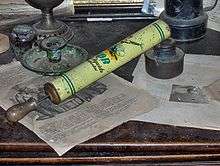Fly spray
Fly spray is a chemical insecticide that comes in an aerosol can that is sprayed into the air to kill flies. Fly sprays will kill various insects such as house flies and wasps.

Principles
Fly spray contains chemicals (including many organophosphate compounds) that bind to and permanently block the action of an enzyme called acetylcholinesterase. Acetyl choline (ACh) is the nerve transmitter substance released by motor neurones (at a site called the neuromuscular junction) to stimulate muscle contraction. The muscles relax (stop contracting) when the ACh is removed from the neuromuscular junction (NMJ) by the action of acetylcholinesterase. By inhibiting the cholinesterase the insect can no longer break down ACh in the NMJ and so its muscles lock up in a state of tetany (continuous contraction) making flying and respiration impossible, and the insect then dies of asphyxiation.
Safety
Fly spray is dangerous to pets as well as fish and should be used with caution.
In the United States, fly sprays often contain the powerful insect toxin dichlorvos which is often targeted by environmental groups as a carcinogenic compound.[1]
